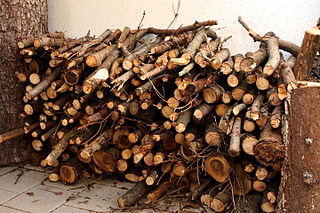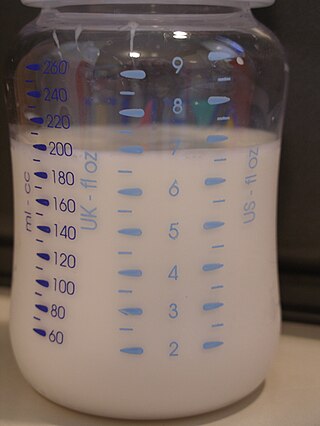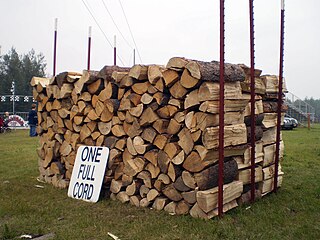Related Research Articles

The inch is a unit of length in the British Imperial and the United States customary systems of measurement. It is equal to 1/36 yard or 1/12 of a foot. Derived from the Roman uncia ("twelfth"), the word inch is also sometimes used to translate similar units in other measurement systems, usually understood as deriving from the width of the human thumb.

The kilogram is the base unit of mass in the International System of Units (SI), having the unit symbol kg. It is a widely used measure in science, engineering and commerce worldwide, and is often simply called a kilo colloquially. It means 'one thousand grams'.

The litre or liter is a metric unit of volume. It is equal to 1 cubic decimetre (dm3), 1000 cubic centimetres (cm3) or 0.001 cubic metres (m3). A cubic decimetre occupies a volume of 10 cm × 10 cm × 10 cm and is thus equal to one-thousandth of a cubic metre.

Ton is any of several units of measure of mass, volume or force. It has a long history and has acquired several meanings and uses.

United States customary units form a system of measurement units commonly used in the United States and most U.S. territories, since being standardized and adopted in 1832. The United States customary system developed from English units that were in use in the British Empire before the U.S. became an independent country. The United Kingdom's system of measures was overhauled in 1824 to create the imperial system, which was officially adopted in 1826, changing the definitions of some of its units. Consequently, while many U.S. units are essentially similar to their imperial counterparts, there are noticeable differences between the systems.

The gram is a unit of mass in the International System of Units (SI) equal to one thousandth of a kilogram.

A fathom is a unit of length in the imperial and the U.S. customary systems equal to 6 feet (1.8288 m), used especially for measuring the depth of water. The fathom is neither an international standard (SI) unit, nor an internationally accepted non-SI unit. Historically it was the maritime measure of depth in the English-speaking world but, apart from within the US, charts now use metres.

Gyros, sometimes anglicized as a gyro in some regions, is meat cooked on a vertical rotisserie, then sliced and served wrapped or stuffed in pita bread, along with other ingredients such as tomato, onion, fried potatoes, and tzatziki. In Greece, it is normally made with pork or sometimes with chicken, whilst beef and lamb are also used in other countries.
The long ton, also known as the imperial ton or displacement ton, is a measurement unit equal to 2,240 pounds (1,016.0 kg). It is the name for the unit called the "ton" in the avoirdupois system of weights or Imperial system of measurements. It was standardised in the 13th century. It is used in the United States for bulk commodities.
Shaku or Japanese foot is a Japanese unit of length derived from the Chinese chi, originally based upon the distance measured by a human hand from the tip of the thumb to the tip of the forefinger. Traditionally, the length varied by location or use, but it is now standardized as 10/33 m, or approximately 30.3 centimeters (11.9 in).

Firewood is any wooden material that is gathered and used for fuel. Generally, firewood is not heavily processed and is in some sort of recognizable log or branch form, compared to other forms of wood fuel like pellets. Firewood can be seasoned and heat treated (dry) or unseasoned (fresh/wet). It is generally classified as either hardwood or softwood.
The rod, perch, or pole is a surveyor's tool and unit of length of various historical definitions. In British imperial and US customary units, it is defined as 16+1⁄2 feet, equal to exactly 1⁄320 of a mile, or 5+1⁄2 yards, and is exactly 5.0292 meters. The rod is useful as a unit of length because integer multiples of it can form one acre of square measure (area). The 'perfect acre' is a rectangular area of 43,560 square feet, bounded by sides 660 feet long and 66 feet wide or, equivalently, 40 rods by 4 rods. An acre is therefore 160 square rods or 10 square chains.
English units were the units of measurement used in England up to 1826, which evolved as a combination of the Anglo-Saxon and Roman systems of units. Various standards have applied to English units at different times, in different places, and for different applications.

The units of measurement of ancient Rome were generally consistent and well documented.
A standard cubic foot (scf) is a unit representing the amount of gas (such as natural gas) contained in a volume of one cubic foot at reference temperature and pressure conditions. It is the unit commonly used when following the customary system, a collection of standards set by the National Institute of Standards and Technology. Another unit used for the same purpose is the standard cubic metre (Sm3), derived from SI units, representing the amount of gas contained in a volume of one cubic meter at different reference conditions. The reference conditions depend on the type of gas and differ from other standard temperature and pressure conditions.

Both the British imperial measurement system and United States customary systems of measurement derive from earlier English unit systems used prior to 1824 that were the result of a combination of the local Anglo-Saxon units inherited from Germanic tribes and Roman units.

The cord is a unit of measure of dry volume used to measure firewood and pulpwood in the United States and Canada.

Google Dictionary is an online dictionary service of Google that can be accessed with the "define" operator and other similar phrases in Google Search. It is also available in Google Translate and as a Google Chrome extension. The dictionary content is licensed from Oxford University Press's Oxford Languages. It is available in different languages, such as English, Spanish and French. The service also contains pronunciation audio, Google Translate, a word origin chart, Ngram Viewer, and word games, among other features for the English-language version. Originally available as a standalone service, it was integrated into Google Search, with the separate service discontinued in August 2011.

The cubic metre or cubic meter is the unit of volume in the International System of Units (SI). Its symbol is m3. It is the volume of a cube with edges one metre in length. An alternative name, which allowed a different usage with metric prefixes, was the stère, still sometimes used for dry measure. Another alternative name, no longer widely used, was the kilolitre.

The imperial and US customary measurement systems are both derived from an earlier English system of measurement which in turn can be traced back to Ancient Roman units of measurement, and Carolingian and Saxon units of measure.
References
- 1 2 3 4 Cardarelli, F. (2003). Encyclopaedia of Scientific Units, Weights and Measures. Their SI Equivalences and Origins . London: Springer. pp. 52. ISBN 978-1-4471-1122-1.
- ↑ "stack | Definition of stack in English by Oxford Dictionaries". Oxford Dictionaries | English. Archived from the original on September 25, 2016. Retrieved 2019-05-17.
- ↑ "Stack dictionary definition | stack defined". www.yourdictionary.com. Retrieved 2019-05-17.
- ↑ ENGLISH - ENGLISH DICTIONARY. V S Publishers. 2015. ISBN 9789350574195.